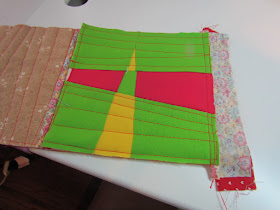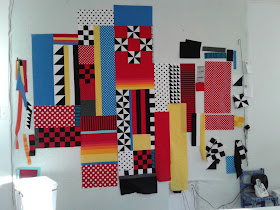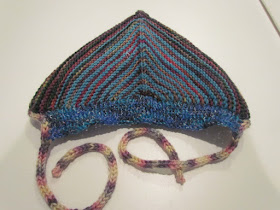 OK, I am pretty excited. I figured out another way to quilt as you go. Here's my trial sample, two small blocks quilted and joined with my new and improved version III method. It really is so much better and easier (if I do say so myself). And they have been squared off before joining, which is also part of the improvement.
OK, I am pretty excited. I figured out another way to quilt as you go. Here's my trial sample, two small blocks quilted and joined with my new and improved version III method. It really is so much better and easier (if I do say so myself). And they have been squared off before joining, which is also part of the improvement.
What you are looking at is a way to connect blocks or even larger sections of a quilt, with fabric to enhance the design, fabric that is special, that you don't want to waste by putting it on the back. Version II used good backing fabric and only a small part of it showed on the front, which I felt was a waste of pretty fabric.
Here's an example of version II quilt as you go. Using 'good' fabric for the backing and cutting it much larger than the blocks that were quilted onto it, the extra edges of the fabric was then used to join the two sections, and then folded over and quilted down.
A problem occurs when quilting distorts the blocks and they can't be trimmed evenly, easily. But with my new version, III, you can quilt the blocks or lengths of blocks, trim them to the edge, so you know they are going to fit, and connect them, which is the next part I want you to see. This is the back side of two blocks joined with contrasting connecting strips. The backing fabric used here purposely for the sample was just some leftover pieces that didn't work, so no biggie.
Sew the connecting strips onto the back of the quilted blocks with right sides together.
It's OK to leave a little extra on the strips which can be trimmed later after the two are sewn together.


 Turning the strips to the front, align the two blocks and sew together with a 1/4" seam. I found that it was necessary to put my foot right onto the block to get my needle as close to the edge as was possible.
Turning the strips to the front, align the two blocks and sew together with a 1/4" seam. I found that it was necessary to put my foot right onto the block to get my needle as close to the edge as was possible.
The strip is folded in half, pressed and pinned and then top stitched through all layers.
Three blocks joined. The strips can now be trimmed even with both blocks.So what makes me happier with this method is:
1. trimming or squaring each of the blocks after quilting them individually
2. adding contrasting connecting fabrics to enhance the design
3. using appropriate backing fabric, or even multiple fabrics, having nothing to do with the design of the top.
4. this is not limited to sewing small blocks together. Panels would work just as easily, which is pretty much what I would do, as it would reduce the number of steps in joining the quilted parts.
5. quilting off the edge of the block and trimming it later. see reason #1.
Anyway, I have plans to do this method with the top I have up on the design wall, unfinished at the moment.
As far as I am concerned, don't even bother with version II, just leap forward to version III and save yourself and your good fabric for the fronts of your work.
UPDATE:
Four big blocks joined with complimentary connecting strips.





























